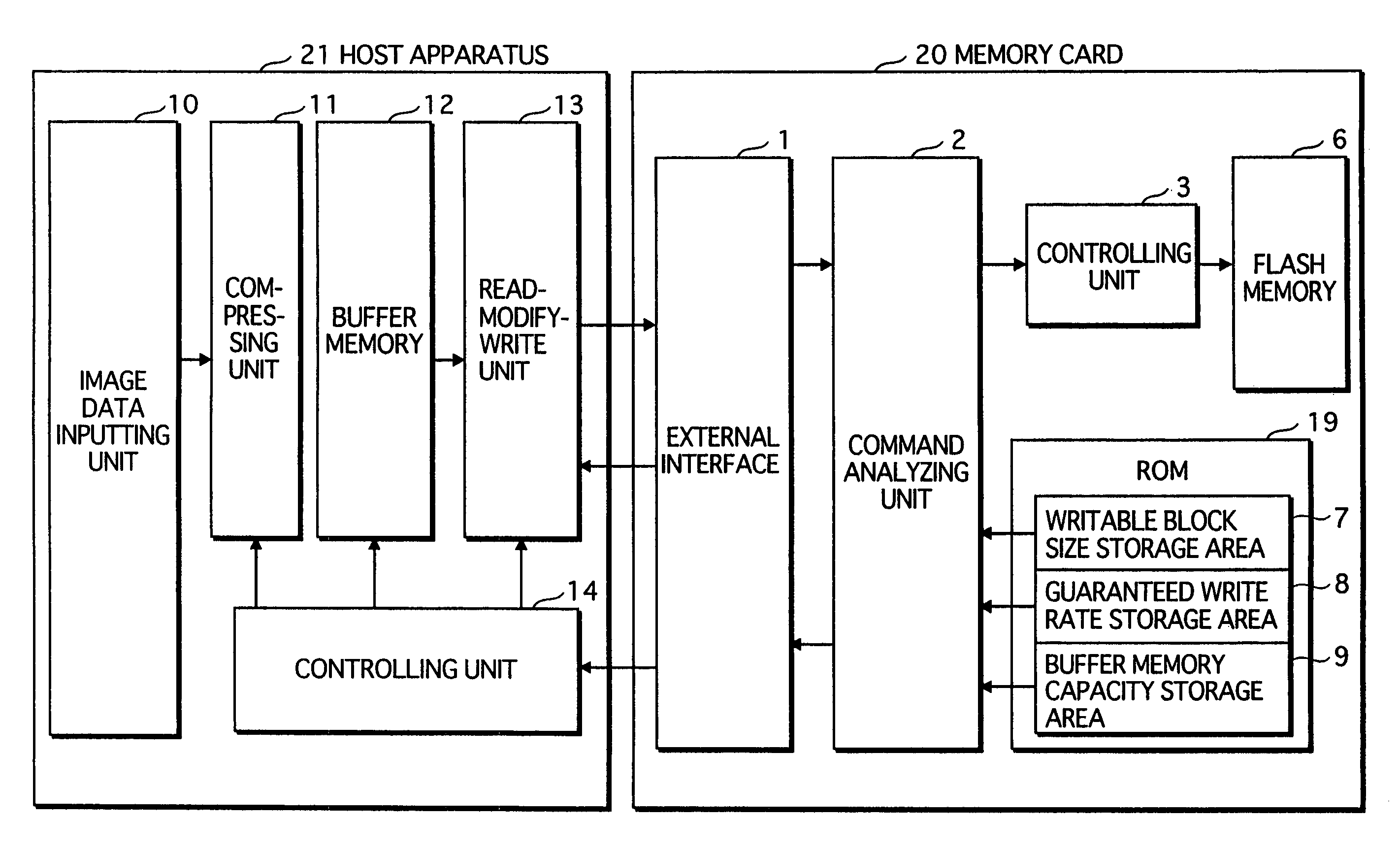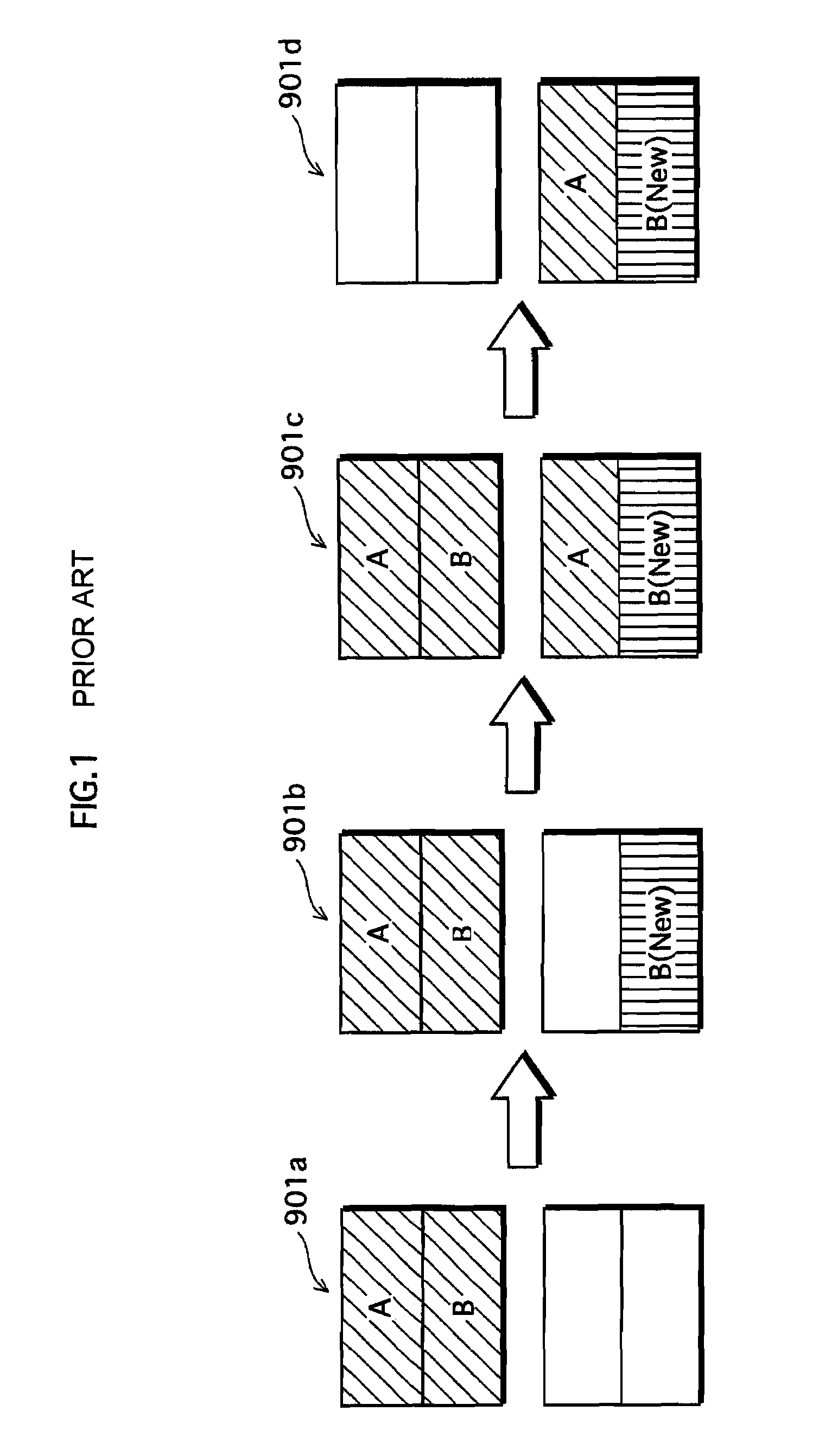Memory card able to guarantee a recoding rate and memory card system using the memory card
a memory card and recoding technology, applied in the field of memory cards, can solve the problems of not having a spec generated, not guaranteeing the system for a high-speed recording of the conventional memory card cannot guarantee so as to achieve the lowest recording rate, guarantee the speed of writing data into the flash memory, and guarantee the effect of the lowest recording ra
- Summary
- Abstract
- Description
- Claims
- Application Information
AI Technical Summary
Benefits of technology
Problems solved by technology
Method used
Image
Examples
first embodiment
[0088]The following describes a memory card of the first embodiment according to the present invention.
[0089]FIG. 4 shows a general structure of a memory card of the first embodiment.
[0090]Here, in FIG. 4, thick arrows show the flow of data from a host apparatus to be recorded into a memory card 20, and thin arrows show the flow of control signal or control data.
[0091]As shown in FIG. 4, the memory card 20 comprises an external interface unit 1, a command analyzing unit 2, a controlling unit 3, a flash memory 6, and a ROM (Read Only Memory) 19 that includes a writable block size storage area 7, a guaranteed write rate storage area 8, and a buffer memory capacity storage area 9.
[0092]Here, the external interface unit 1 receives a command from a host apparatus and sends, to the host apparatus, a response against the command issued by the host apparatus. The external interface unit 1 also transfers data.
[0093]The command analyzing unit 2 analyzes the command received by the external in...
second embodiment
[0151]The following explains a memory card system according to the second embodiment of the present invention.
[0152]FIG. 9 shows a general structure of a memory card system according to the second embodiment.
[0153]As shown in FIG. 9, the memory card system is composed of the memory card 20 described in the first embodiment and a host apparatus 21 that records data into the memory card. Here the explanation is provided on a case where a camera recorder is used as the host apparatus 21.
[0154]The host apparatus 21 includes an image data input unit 10, a compressing unit 11, a buffer memory 12, a read-modify-write unit 13, and a controlling unit 14.
[0155]The image data input unit 10 is where digital image data is input.
[0156]The compressing unit 11 compresses the image data that is input through the image data input unit 10.
[0157]The buffer memory 12 temporarily stores the image data.
[0158]The read-modify-write unit 13 records the data read from the buffer memory 12 into the memory card...
third embodiment
[0171]The following explains a memory card 30 that is generated by partly deforming the memory card 20 of the first embodiment.
[0172]The memory card 20 divides, to prevent a recording rate from becoming lower than a predetermined rate, data into writable block sizes which are integral multiples of an erase block and accepts writings of data from the host apparatus only in units of integral multiples of the writable block sizes, and regards other writings as errors. Therefore, the host apparatus has a function to read the writable block size 7 stored in the ROM 19. On the other hand, a memory card 30 stores the writable block size not in the ROM 19 but in a nonvolatile re-writable memory that is different from the flash memory 6, and updates the writable block size under given conditions.
[0173]FIG. 11 shows a general structure of the memory card 30 according to the third embodiment. Here, in FIG. 11, components of the memory card 30 according to the present embodiment that are the sa...
PUM
 Login to View More
Login to View More Abstract
Description
Claims
Application Information
 Login to View More
Login to View More - R&D
- Intellectual Property
- Life Sciences
- Materials
- Tech Scout
- Unparalleled Data Quality
- Higher Quality Content
- 60% Fewer Hallucinations
Browse by: Latest US Patents, China's latest patents, Technical Efficacy Thesaurus, Application Domain, Technology Topic, Popular Technical Reports.
© 2025 PatSnap. All rights reserved.Legal|Privacy policy|Modern Slavery Act Transparency Statement|Sitemap|About US| Contact US: help@patsnap.com



